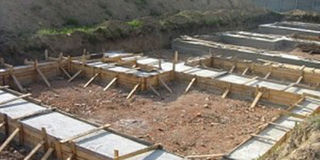Procedures of building a foundation

A foundation must be built in such a way that it can carry (transfer) the entire weight of the building, the furniture, fixtures and installations, occupants in it.
Constructing a house requires a number of technical procedures that must be carried out to ensure a strong building and long lasting house. A few procedures that are followed to ensure a strong foundation for houses are discussed below.
Site clearing, stripping and levelling
This is the clearing of the site by removing, rubble, grass, shrubs, trunks and also ensuring that there is no water stagnation by incorporating a proper drainage system. Some of the procedures that are required before any excavations can begin are explained below.
Setting out and excavation
After the site has been cleared, setting out of the building may commence by following the guidelines of the local authorities, for example, in some areas, you are required to set the building not less than 1.5m approximately (5feet) from the plot boundary line.
After setting out, the digging up of the foundation trenches may commence, as specified in the building plans, these excavations have to be supervised strictly because any shortcuts made on the foundation will affect the entire structure.
Footing
Concrete of a specified mix is prepared and poured into the excavated trenches up to a specified thickness and width. Ordinarily the foundation footing shouldn’t be less than 600mm (two feet) wide, and not less than 200mm (about eight inches) thick.
Foundation Wall (plinth wall)
A wall built from the concrete strip footing to the height of the foundation slab, the thickness of the foundation wall may vary from site to site, so the walls are built as the building plans specify.
Backfill and dump proofing
The inside of the built foundation walls must be filled to a required level, either by using the excavated soil, or ferried one, this soil should be compacted in layers to get desired results, it’s important to spray some water onto the soil to dampen it (not soak the material completely) .
On top of the compacted soil, you will need a layer of hardcore filling, of a specified thickness to a required level, a layer of sand is poured on top of the hardcore (blinding) to achieve a smooth level,.
A dump proofing membrane (DPM) is then laid on top of the sand blinding; this prevents the ground water and moisture from rising to the floor slab.
A reinforcing mesh also known as BRC is laid on top of the Dump proof Membrane and the ends overlapped and tied with binding wire.
It’s at this point that the concrete of a specified mix is prepared and poured onto the mesh, to a specified thickness.
Other procedures not discussed that are still important in ensuring a strong foundation, include, soil testing, termite treatment and the need for a ground beam.
These guidelines are only intended to shed some light on some of the procedures that are followed in building a strip foundation of ordinary houses.
However every construction work demands specific procedures and some of these are technical for layman to understand deeply, therefore be sure to seek guidance from 99m your architect or structural engineer to advice you more, basing on your site conditions, as different sites will require different procedures and approach.




